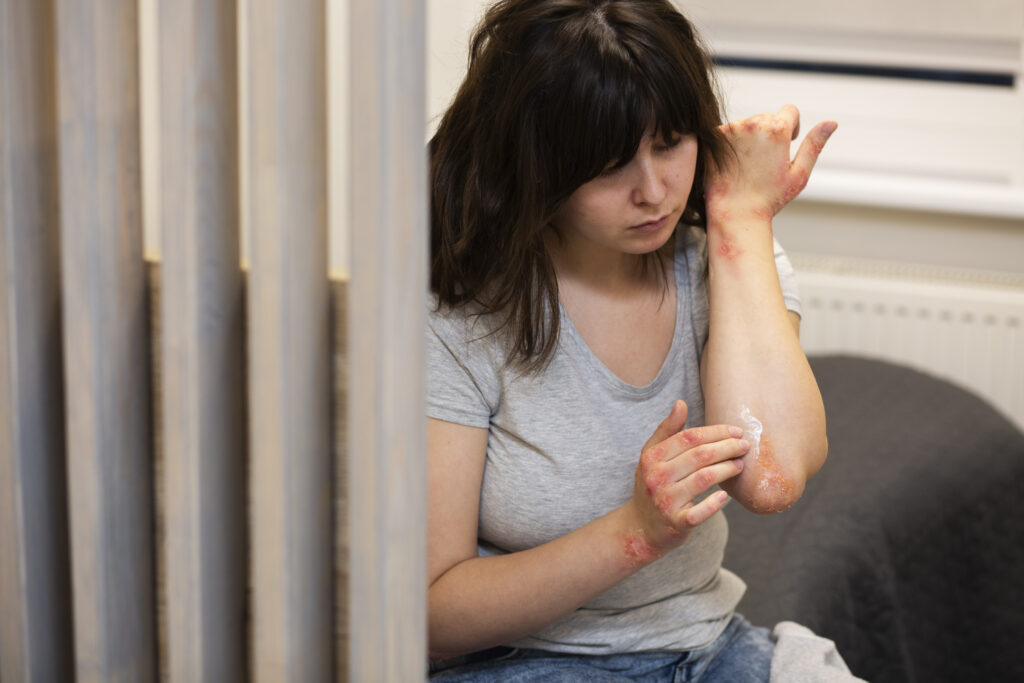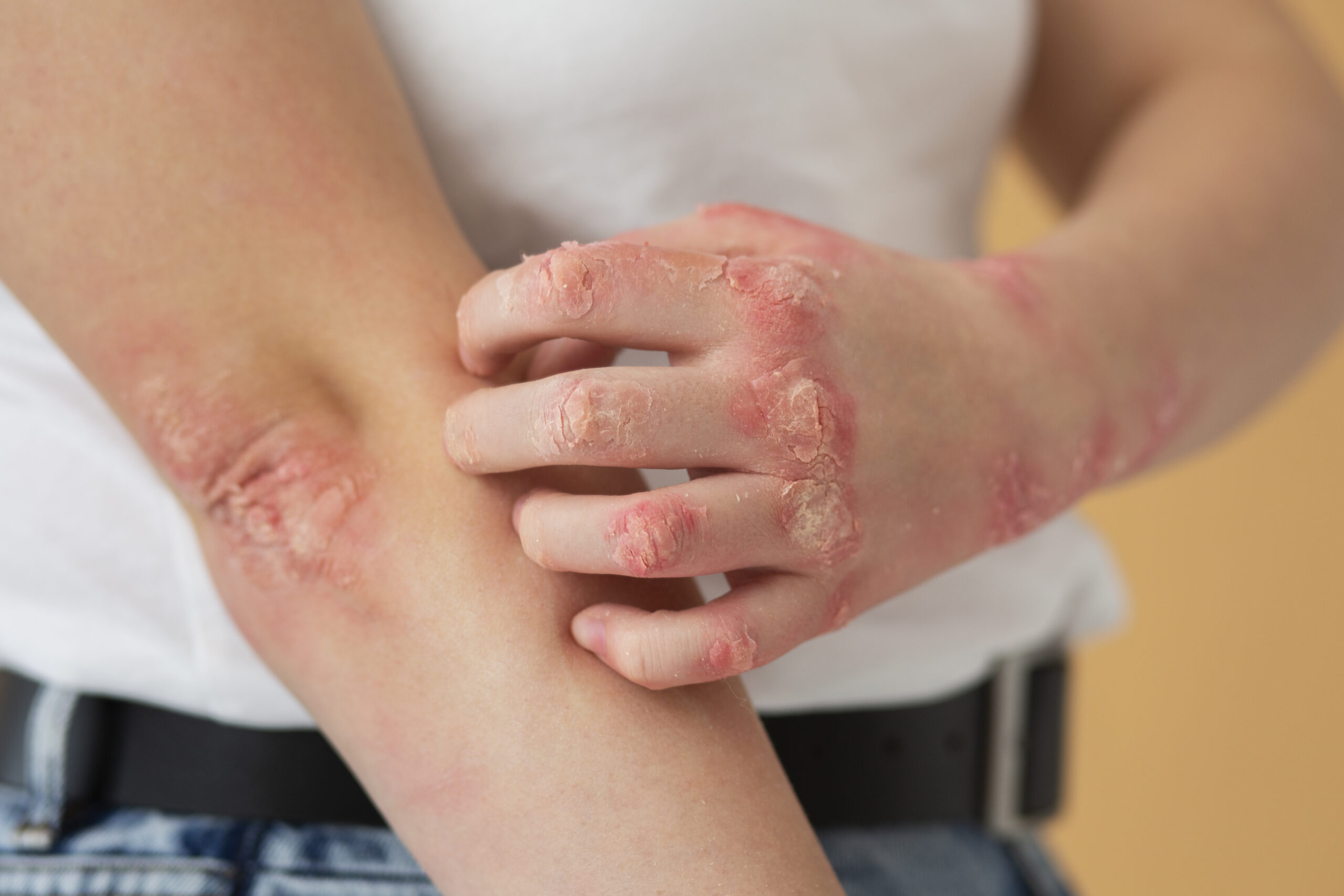Psoriasis is a long term, immune mediated skin condition where skin cells grow too fast, building up as thick, red, scaly patches that can itch or hurt. Although many skin issues are mild, psoriasis can range from barely noticeable patches to widespread plaques that deeply affect quality of life.
Around 125 million people globally have psoriasis, making it one of the most common chronic skin conditions in the world. Sources like the Global State of Psoriasis Epidemiology study and health organizations confirm the number and warn that it is increasing each year owing to environmental, genetic, and lifestyle factors.
In this post, we’ll first define what psoriasis is and how it affects people, then examine its symptoms, explore its main triggers, describe types, and finally review the latest treatment options available in 2025.
What Is Psoriasis?
Psoriasis is not just a temporary rash or sensitivity, it is a systemic, immune-driven skin disorder. In psoriasis, the immune system becomes overactive, sending signals that cause skin cell turnover to accelerate.
Rather than taking a normal month to renew, skin cells pile up within days, forming thick, inflamed patches covered in silvery scales. People with psoriasis often have cycles of flare-ups and remission.
During flare-ups, symptoms worsen, during remission, symptoms may shrink or temporarily disappear, but without treatment, plaques often return. Psoriasis also has coexisting impacts, not only on skin but on nails, joints (psoriatic arthritis), emotional health, and daily life.
Psoriasis Symptoms
The symptoms of psoriasis typically include patches of thickened, red skin with silvery or white scale on top. These patches can feel itchy, burn, or sting, and may crack and bleed when severe. Nail changes are common: you might notice pitting, changes in color, or the nail separating from its bed.
Some people develop arthritis along with skin symptoms (psoriatic arthritis), which causes joint pain, stiffness, and swelling. Symptoms tend to occur in symmetrical areas, such as both elbows or knees, and often worsen with certain triggers or stress.
Different Psoriasis Types That You Must Know
Psoriasis is not the same for everyone. It appears in different forms, each with unique symptoms and severity levels. Understanding the psoriasis types is essential for proper diagnosis and treatment.

1. Plaque Psoriasis (Psoriasis Vulgaris)
This is the most common form, affecting nearly 80–90% of patients. It appears as raised, inflamed red patches covered with silvery-white scales, often on the elbows, knees, scalp, and lower back. These patches can be itchy, painful, and may crack or bleed in severe cases.
2. Guttate Psoriasis
Usually triggered by bacterial infections like strep throat, this type shows up as small, red, drop-shaped spots across the torso, arms, or legs. It is more common in children and young adults and may either resolve with treatment or develop into chronic plaque psoriasis.
3. Inverse Psoriasis
Unlike other types, inverse psoriasis appears as smooth, shiny red lesions without thick scales. It commonly develops in skin folds such as under the breasts, around the groin, and buttocks, where sweat and friction can worsen discomfort and irritation.
4. Pustular Psoriasis
This rare but serious type is marked by white pustules (blisters filled with non-infectious pus) surrounded by inflamed skin. It can affect small areas like the hands and feet or spread widely, causing severe itching, pain, and systemic symptoms such as fever or chills.
5. Erythrodermic Psoriasis
The rarest and most severe type, erythrodermic psoriasis, covers large portions of the body with fiery redness, intense itching, and shedding of skin in large sheets. It can disrupt body temperature regulation and requires immediate medical attention due to life-threatening complications.
ALSO READ
Skin Cancer Symptoms, Types, And Treatments
What are the Most Common Triggers of Psoriasis?
Psoriasis flare-ups don’t occur randomly, they are often linked to specific triggers. Identifying and managing these triggers can make a significant difference in controlling the condition and reducing flare severity.
Stress
Stress is one of the most powerful triggers for psoriasis because it weakens the immune system and causes hormonal imbalances. Many people notice flare-ups during emotionally challenging times, making stress management techniques like meditation and yoga essential for relief.
Infections
Bacterial or viral infections, such as strep throat or respiratory illnesses, can activate the immune system and worsen psoriasis. These flare-ups are particularly common in guttate psoriasis and may require both infection treatment and targeted skin therapy.
Medications
Certain drugs, including beta-blockers for high blood pressure, lithium for mental health conditions, and antimalarials, are known to aggravate psoriasis. If symptoms worsen after starting a medication, a doctor should be consulted for safer alternatives.
Weather Changes
Cold and dry weather often dries out the skin, making psoriasis patches thicker and itchier, while hot, humid weather may provide some relief. However, too much sun exposure can lead to sunburn, which can also worsen the condition.
Alcohol and Smoking
Both alcohol and tobacco are strongly linked to psoriasis flare-ups and reduced treatment effectiveness. Heavy drinking and smoking can intensify symptoms and increase the risk of developing more severe forms of psoriasis over time.
Skin Injuries (Koebner Phenomenon)
Even minor cuts, scrapes, insect bites, or burns can trigger new psoriasis patches in the injured area. This response, known as the Koebner phenomenon, makes it important to protect the skin and treat wounds carefully to avoid flare-ups.
Certain Medications
Some prescription drugs, like beta-blockers (for blood pressure), lithium (for mental health), or antimalarial medicines, have been shown to trigger or worsen psoriasis in certain people. These medications can disrupt immune system activity, leading to flare-ups that may persist until the drug is adjusted or replaced under medical supervision.
Latest Treatments for Psoriasis
Managing psoriasis has advanced greatly in recent years, with treatments now targeting both the skin and the immune system. The goal is not only to relieve symptoms like itching and scaling but also to prevent flare-ups and improve overall quality of life. Below are the most effective modern treatment options being used in 2025.
1. Topical Treatments
Topical treatments remain the first line of defense for mild to moderate psoriasis. These include corticosteroid creams, vitamin D analogs, salicylic acid, coal tar, and moisturizers that help reduce scaling and itching. They are usually applied directly to the patches and can bring significant short-term relief.
However, the effectiveness of topical treatments often depends on consistency and severity of the disease. For some patients, they work best when combined with other therapies, such as phototherapy or systemic drugs. Dermatologists usually personalize topical care to suit the skin’s sensitivity and the affected body areas.
2. Phototherapy (Light Therapy)
Phototherapy involves controlled exposure of the skin to ultraviolet (UV) light, which slows down the rapid skin cell growth seen in psoriasis. It can be highly effective for people with moderate psoriasis who do not respond well to creams. Sessions are usually conducted in a dermatologist’s clinic under supervision to avoid side effects like burns.
The treatment not only reduces scaling and inflammation but also provides longer remission for some patients. However, it may require multiple weekly sessions, which can be time consuming. Advances in home phototherapy devices are now making this option more accessible.
3. Systemic Medications
For moderate to severe cases, oral or injected systemic medications are prescribed. Drugs like methotrexate, cyclosporine, and acitretin work by suppressing the overactive immune response that drives psoriasis. These medications are effective in controlling symptoms and preventing flare-ups.
Still, systemic drugs often come with potential side effects, including liver or kidney strain, making regular monitoring essential. Because of these risks, doctors usually recommend systemic treatments only when topical and light therapies are not sufficient.
4. Biologic Therapies
Biologics are one of the most revolutionary advances in psoriasis care. These injectable drugs, such as adalimumab, ustekinumab, and secukinumab, target specific immune system proteins that cause inflammation and abnormal skin growth. They are highly effective in reducing plaques and keeping the condition under long-term control.
Unlike traditional medications, biologics are more precise, which means fewer side effects for many patients. They have become a preferred choice for people with severe psoriasis or psoriatic arthritis, although they can be expensive and require medical supervision.
5. Lifestyle and Integrative Approaches
Alongside medical treatments, lifestyle changes play a major role in managing psoriasis. Eating an anti-inflammatory diet, maintaining a healthy weight, and reducing alcohol or tobacco use can significantly improve skin health and treatment effectiveness. Stress-reduction techniques like meditation, yoga, and mindfulness are also widely recommended.
Integrative approaches, such as supplements, herbal remedies, and holistic skincare, are gaining attention in 2025. While not replacements for medical care, these methods complement conventional treatments and provide patients with a more balanced, long-term way to manage psoriasis.
FAQs
Is psoriasis contagious or hereditary?
Psoriasis is not contagious, you cannot catch it from another person. Its roots lie in genetics and immune dysregulation. If someone in your family has psoriasis, your risk is higher, but having that risk does not guarantee you’ll develop it.
What is the usual age of onset, and can children develop it?
Psoriasis can appear at any age, but often first shows up between late teens and early adulthood. In many cases, symptoms begin by age 20–30. Children can get it too, their symptoms may look different, more often appearing on the face or scalp.
How long does treatment take to show visible improvement?
With topical treatments, some improvement can be seen in a few weeks, especially with consistent use. With systemic or biologic drugs, it may take several months for plaques to flatten and symptoms to lessen significantly. Patience and adherence are essential.
Are there side effects with newer biologic treatments?
Yes, though generally newer biologics are safer than older systemic drugs, possible side effects include risk of infection, reactions at injection sites, or immune suppression. Doctors usually screen for liver function and other health parameters before starting.
What home care helps alongside medical treatment?
Using fragrance-free moisturizers, gentle cleansers, avoiding harsh soaps or scrubs, wearing comfy clothing, and managing stress all help. Sunlight (in controlled amounts) and a balanced diet with omega-3s can support skin healing in many sufferers.
Key Takeaway
Psoriasis is a lifelong condition, but it does not have to dictate your daily life. Recognizing its distinct symptoms, understanding your triggers, and choosing the right treatment path, whether topical creams, light therapy, systemic drugs, or biologics, can control flare-ups and improve comfort.
In 2025, treatments will have become more personalized, combining biological treatments with better topical options and lifestyle changes. With guidance from a dermatologist, many people with psoriasis manage their condition in ways that reduce discomfort, improve appearance, and restore confidence.
Sources: National Library of Medicine




Join The Discussion